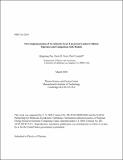| dc.contributor.author | Pan, Qingjiang | en_US |
| dc.contributor.author | Ernst, Darin R. | en_US |
| dc.contributor.author | Crandall, Paul | en_US |
| dc.date.accessioned | 2025-03-21T20:21:06Z | |
| dc.date.available | 2025-03-21T20:21:06Z | |
| dc.date.issued | 2020-03 | |
| dc.identifier | 20ja009 | |
| dc.identifier.uri | https://hdl.handle.net/1721.1/158702 | |
| dc.description | Submitted for publication in Physics of Plasmas | |
| dc.description.abstract | Gyrokinetic simulations are fundamental to understanding and predicting turbulent transport in magnetically confined fusion plasmas. Previous simulations have used model collision operators with approximate field-particle terms of unknown accuracy and/or have neglected collisional finite Larmor radius (FLR) effects. We have implemented the linearized Fokker–Planck collision operator with exact field-particle terms and full FLR effects in a gyrokinetic code (GENE). The new operator, referred to as “exact” in this paper, allows the accuracy of model collision operators to be assessed. The conservative Landau form is implemented because its symmetry underlies the conservation laws and the H-theorem, and enables numerical methods to preserve this conservation, independent of resolution. The implementation utilizes the finite-volume method recently employed to discretize the Sugama collision model in GENE, allowing direct comparison between the two operators. Results show the Sugama model appears accurate for the growth rates of trapped electron modes (TEMs) driven only by density gradients, but appreciably underestimates the growth rates as the collisionality and electron temperature gradient increase. The TEM turbulent fluxes near the nonlinear threshold using the exact operator are similar to the Sugama model for the eta_e=0 case, but substantially larger than the Sugama model for the eta_e=1 case. The FLR effects reduce the growth rates increasingly with wavenumber, deepening a “valley” at the intermediate binormal wavenumber as the unstable mode extends from the TEM regime to the electron temperature gradient (ETG) instability regime. Application to the Hinton–Rosenbluth problem shows zonal flows decay faster as the radial wavenumber increases and the exact operator yields weaker decay rates. | |
| dc.publisher | AIP | en_US |
| dc.relation.isversionof | doi.org/10.1063/1.5143374 | |
| dc.source | Plasma Science and Fusion Center | en_US |
| dc.title | First Implementation of Gyrokinetic Exact Linearized Landau Collision Operator and Comparison with Models | en_US |
| dc.type | Article | en_US |
| dc.contributor.department | Massachusetts Institute of Technology. Plasma Science and Fusion Center | |
| dc.relation.journal | Physics of Plasmas | |
